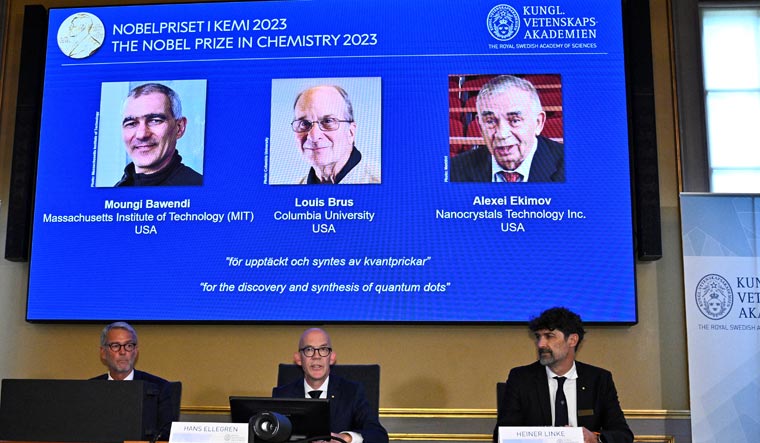The Nobel Prize in Chemistry has been awarded to Moungi Bawendi, Louis E. Brus, and Alexei I. Ekimov for their pioneering research on quantum dots —minuscule particles that have revolutionised the field of nanotechnology.
The Royal Swedish Academy of Sciences, in its announcement, hailed the trio's research for its transformative impact. Quantum dots have not only adorned television screens and LED lamps with their brilliance, but also serve as catalysts in chemical reactions. Furthermore, their pristine light has proven invaluable in illuminating tumor tissues during surgeries, aiding surgeons in their delicate procedures.
Hans Ellegren, the secretary-general of the academy, revealed the highly prestigious award at a ceremony held in Stockholm on Wednesday.
Quantum dots, measuring only a few atoms in diameter, possess a remarkable property of restricted electron movement. This unique characteristic has had a profound impact on their ability to absorb and emit visible light, resulting in an extraordinary range of vibrant colors. These luminous particles have found wide-ranging applications in electronic devices, most notably in LED displays.
Moungi Bawendi,a distinguished researcher at the Massachusetts Institute of Technology (MIT) in Cambridge, MA, USA, has made significant contributions to the field of nanotechnology. His research has focused on the synthesis and characterisation of quantum dots, which are semiconductor nanocrystals with unique optical and electronic properties.
Louis E. Brus, the S. L. Mitchell Professor of Chemistry at Columbia University, is a key figure in the development of quantum dots. His pioneering work on colloidal semiconductor nanocrystals has led to numerous breakthroughs in the field. Quantum dots, discovered by Brus, are tiny particles with exceptional optical properties due to their size-dependent behavior. These nanocrystals have found applications in fields such as electronics, medicine, and energy.
Alexei I. Ekimov, currently associated with Nanocrystals Technology Inc. in New York, has also made significant contributions to the field of quantum dots. Ekimov's work aligns with the discovery and development of these remarkable nanocrystals. Ekimov's research has focused on the synthesis and characterisation of quantum dots, exploring their fascinating properties and potential applications in various fields. His contributions have played a crucial role in advancing the field of nanotechnology and have opened up new possibilities for technological innovation.
The recognition of Bawendi, Brus, and Ekimov's groundbreaking work highlights the immense potential of quantum dots and their significant contributions to the field of chemistry.
The Nobel Prizes carry a monetary reward of 11 million Swedish kronor ($1 million), funded by a bequest left by the prize's founder, Swedish inventor Alfred Nobel, who passed away in 1896.
The Royal Swedish Academy of Sciences, responsible for bestowing the physics, chemistry, and economics prizes, solicits nominations from thousands of university professors and scholars worldwide a year in advance.
Subsequently, dedicated committees for each prize convene over the course of the year to deliberate on candidates. At the conclusion of this meticulous process, the committee presents one or more nominations to the entire academy for a vote. The details of these deliberations, including the names of nominees other than the laureates, remain confidential for half a century.
On Tuesday, the Nobel Prize in physics was awarded to French-Swedish physicist Anne L'Huillier, French scientist Pierre Agostini, and Hungarian-born Ferenc Krausz for their pioneering work, providing a fleeting glimpse into the high-speed realm of spinning electrons.
These tiny components within each atom orbit the nucleus and play a fundamental role in an array of fields, including chemistry, physics, biology, and modern technology.
Last year, the Nobel Prize in chemistry was jointly awarded to Americans Carolyn R Bertozzi and K Barry Sharpless, along with Danish scientist Morten Meldal. They were honored for their groundbreaking method of joining molecules, a technique that facilitates the exploration of cells, DNA mapping, and the precise targeting of diseases such as cancer with pharmaceuticals.
The Nobel Prize in chemistry marks the midpoint of the Nobel season, with announcements for literature, peace, and economics to follow, one each weekday until October 9th.
This year, the Nobel Foundation has increased the prize money by 10 percent to 11 million kronor (approximately $1 million). In addition to the financial reward, laureates receive an 18-carat gold medal and a diploma during the Nobel Prize award ceremonies scheduled for December.


